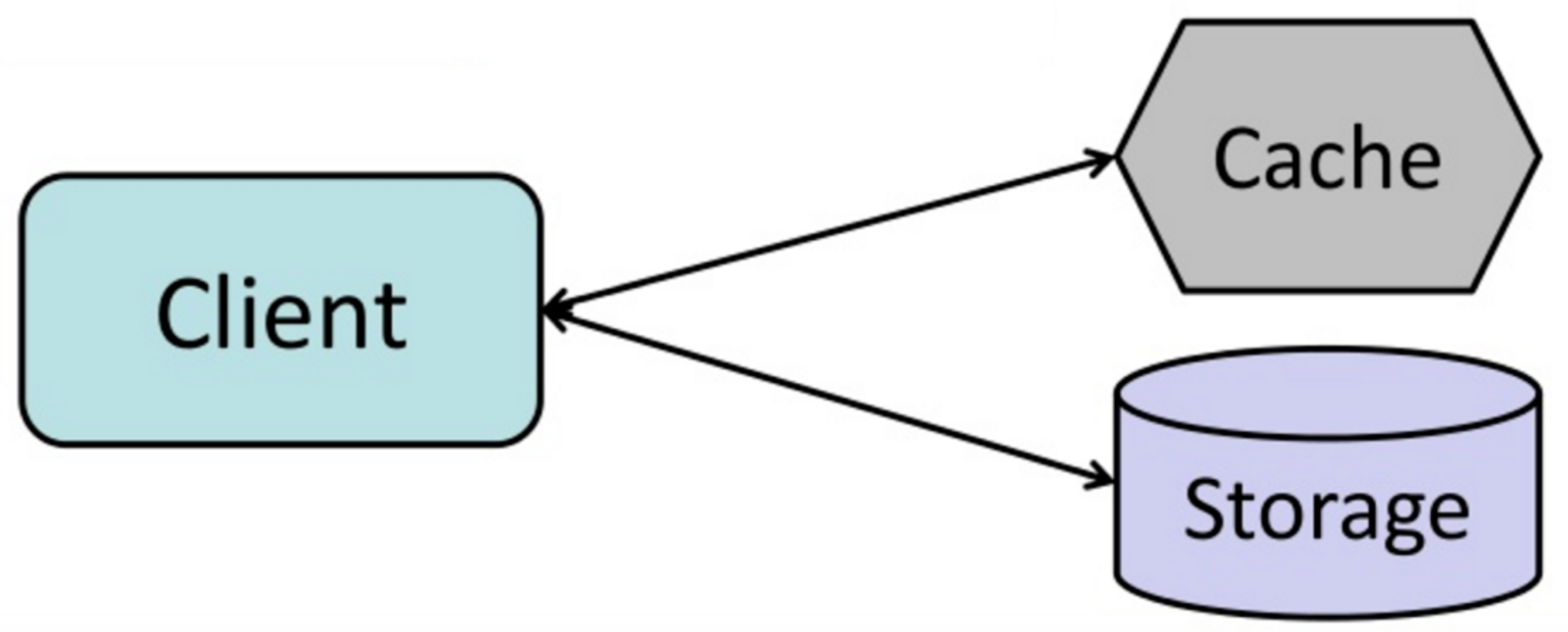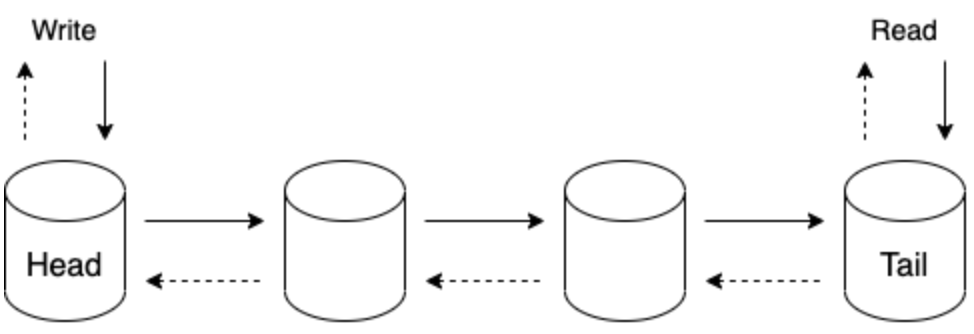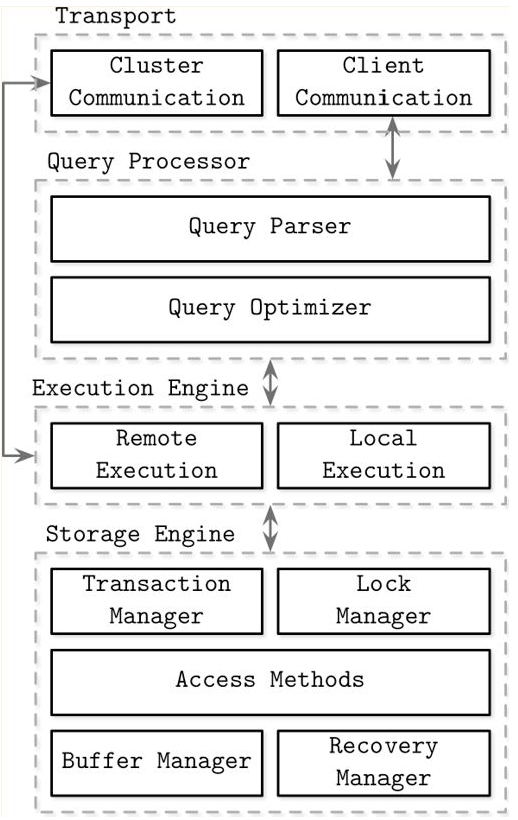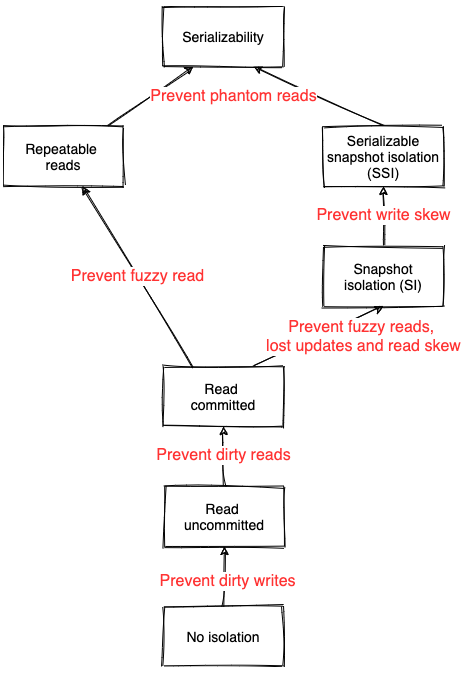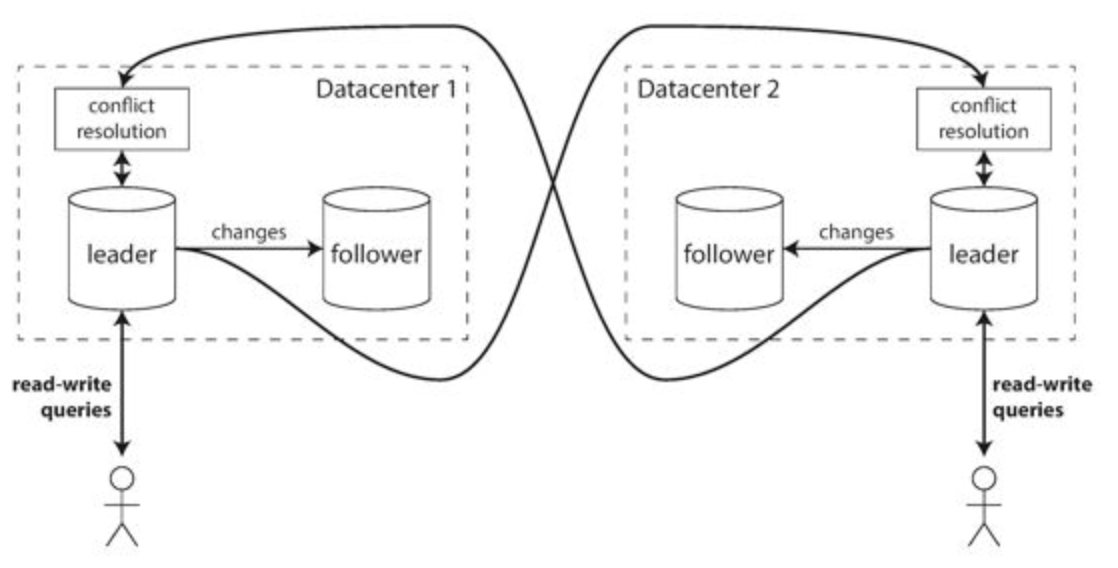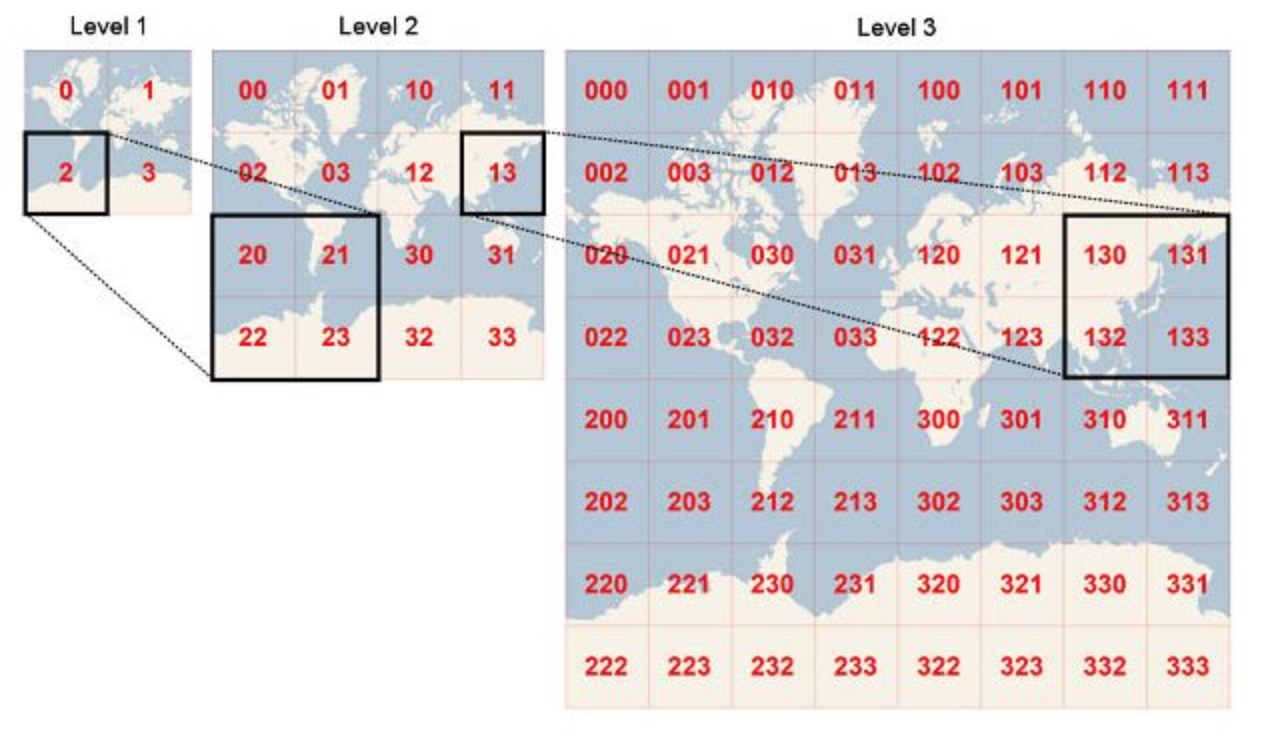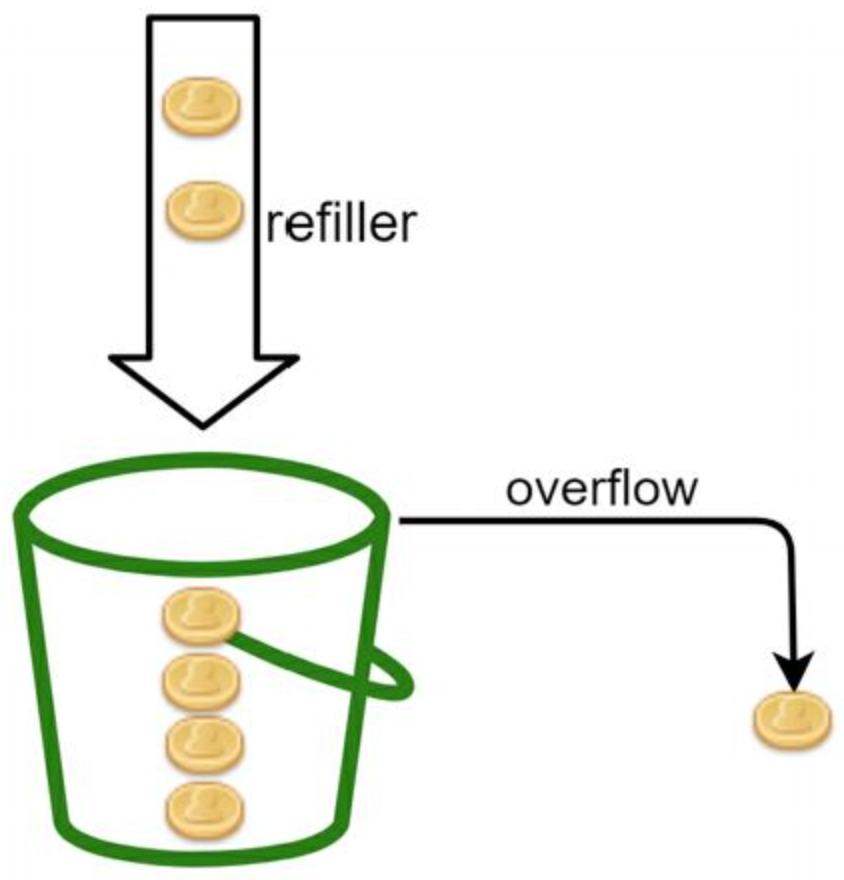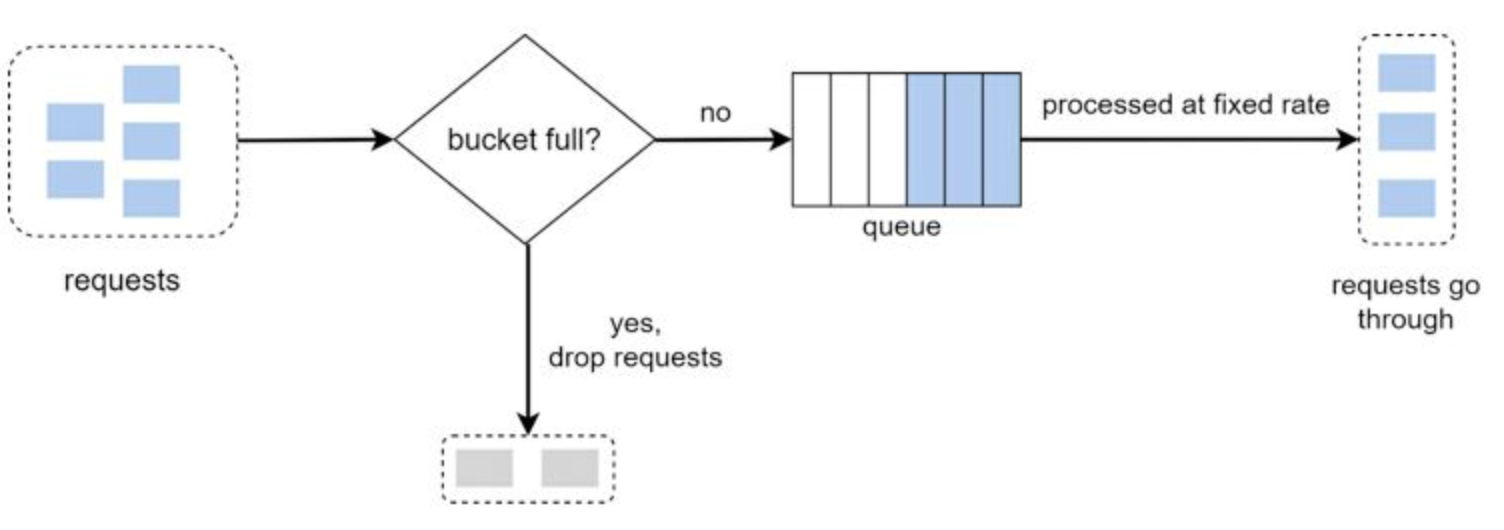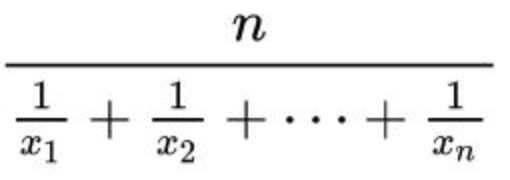Design Deck
Anki
Check the Anki version here.
The Coder Cafe
If you enjoyed this resource, you may be interested in my latest project: The Coder Cafe, a newsletter for coders.
Feeling overwhelmed by the endless stream of tech content? At The Coder Cafe, we serve one essential concept for coders. Written by a senior software engineer at Google, it's perfectly brewed for your morning coffee, helping you grow your skills deeply.

Cache
Cache aside
Application is responsible for reading and writing to the DB (using write-through or write-back policy)
The cache doesn't interact with the storage directly
Cache aside vs. read-through
Cache aside: - Data model can be different from DB
Read-through: - Same data model as DB - Can use the refresh-ahead pattern
Cache eviction policy
- LRU (Least Recently Used)
- LFU (Least Frequently Used)
- FIFO
Cache locations
- Client caching
- CDN
- In memory
- Distributed cache
- Database caching (query or object)
Cache: refresh-ahead
Cache to automatically refresh any recently accessed entry prior to its expiration
Used with read-through cache
- Pro: can result in reduced latency
- Con: not accurately predicting which items are likely to be needed in the future
Cache: write through vs. write back
Main difference: consistency
Write through: 1. Write to the cache and the DB in a single DB transaction (may still lead to cache inconsistency if the DB commit failed) 2. Return
Write back: 1. Write to the cache 2. Return 3. Asynchronously store in DB
Four main distributed cache benefits
- Improve read latency
- Can improve availability (e.g., DB unavailable, responses are served from the cache)
- Save computation time (e.g., SQL computation)
- Independently scalable from the rest of the system
Main metric for cache
Cache hit ratio: hits / total accesses
Read-through cache
Read-through cache sits in-line with the DB
Single entry point
When to use a cache
- Speed up reads
- Response complex to compute
Cloud
CDN
Content Delivery Network
Network of geographically dispersed servers used to deliver static content (images, CSS, Javascript files, etc.)
Two kinds of CDNs: - Push CDN: we are responsible for providing the content - Pull CDN: CDN is responsible for pulling the right content (expiration to be used)
Pull is easier to handle whereas push gives us more flexibility
Use case for pull: Docker Hub S3 layer
DB
3 main reasons to partition data
- Scalability
- Improve performance of write heavy systems (usually, for example, key range partitioning can improve reads)
- Dataset doesn’t fit into a single node
ACID property
-
Atomic: all transaction succeeds or none does (all or nothing)
-
Consistency: from one valid state to another (invariants must always be true)
Not necessarily a property of the DB (e.g., foreign key constraint), can be a property of the application (e.g., credits and debits must be balanced)
Different from consistency in eventual consistency (which is more about convergence as the matter is replicating data)
- Isolation: a transaction is not affected by another ongoing transaction (a transaction cannot read from another transaction that has not yet been completed)
Refers to serializability
- Durability: once a transaction is committed, it will remain in the system
Anti-entropy
Optimization to favor latency over consistency when writing to a DB (e.g., leaderless replication)
Background process to constantly looks for differences in data
Could be used as an alternative or in conjunction with read repair
Byzantine fault-tolerant
A system is Byzantine fault-tolerant if it continues to operate correctly if in the case of a Bizantine's problem (some of the nodes malfunctioning, not obeying the protocol or malicious attackers).
CALM theorem
Consistency As Logical Monotonicity
A program has a consistent, coordination-free (e.g., consensus-free) distributed implementation if and only if it is monotonic
Consistency in this context doesn't mean linearizability. It focuses on the consistency of the program's output while traditional consistency focus on the consistency of reads and writes.
In CALM, a consistent program is one that produces the same output no matter in which order the inputs are processed and despite any conflicts.
Said differently, does the implementation produce the outcome we expect despite any race condition that may arise.
CAP theorem
Consistency, availability, partition tolerance (e.g., one node cut off from the rest of the cluster because of a network partition) => pick 2 out of 3
C refers to linearizability
Caveat of serializability
It's possible that serial order is different from the order in which transactions were actually run (latest may not win)
If not, we need a stricter isolation level: strict serializability (serializability + linearizability)
Chain replication
Replication protocol that uses a different topology than leader based replication protocols like Raft
Left-most process referred as the chain's head, right-most as the chain's tail: - Client send writes to the head, which updates its local state and forwards to the next process in the chain - Next process updates its local state and forwards to the next process in the chain - Etc. - Once the update is received by the tail, the ack flows back to the head which replies to the client that the write succeeded
Fault tolerance is delegated to a dedicated component: control plane - If head fails: the control plane removes it and makes the next as the head - If intermediate node fails: the control plane removes it temporarily from the chain, and then adds it back eventually as the tail - If tail fails: the control plane removes it and makes the predecessor as the new tail
Benefits: - Strongly consistent protocol - Reads are served from the tail without contacting other replicas first which allows a lower response time
Drawbacks: - Writes are slower than quorum-based replication. - A single slow node can slow down all writes. - As reads are served from a single node, it can't be scaled horizontally. A mitigation is to allow intermediate nodes to serve reads but they can do it only if a read is considered as clean (the ack for this object has been returned to the predecessor). // The tail serves as the authority of the latest clean version
Notes: - To avoid the overhead of having a single node handling the writes, we can find a way to shard data and handle multiple chains (see https://engineering.fb.com/2022/05/04/data-infrastructure/delta/)
Chain replication vs. consensus
Similar consistency guarantees
Chain replication: - Optimized for reads for CP systems - Better read availability: a chain of n nodes can tolerate up to n-2 nodes failure
Example with 5 nodes: - Chain replication: tolerate up to 3 nodes failure - Consensus with R=3 and W=3: tolerate up to 2 nodes failure
Consensus: - Optimized for writes for CP systems
Change data capture (CDC)
A datastore is selected as the authoritative source of data where all update operations are performed
An event log is then created from this datastore that is consumed by all the remaining operations the same way as in event sourcing
Concurrency control
Ensures that correct results for concurrent operations are generated
Pessimistic: lock (mutual exclusion)
Optimistic: checks for conflicts at the end of a transaction
In the end, concurrency control serves the same purpose as atomicity
Consensus
Set of processes agreeing on some data value in a fault-tolerant way
Satisfies safety and liveness
Consistency models
Describe what expectations clients might have in terms of possible returned values despite the existence of multiple copies of data and concurrent access to it
Not the C in ACID but the C in CAP (converging to an end state)
-
Eventual consistency: all the nodes converge to the same state (not necessarily the latest)
-
Write follow reads: ensures that writes are ordered after writes that were observed by previous read operations
Example: - P1 reads value => foo - P1 updates value to bar => Every node will converge to bar (a process can't read bar, then foo, regardless of the process) Also known as session causality
-
Monotonic reads consistency: a client doing several reads in sequence will never go backward in time
-
Monotonic writes consistency: values originating from the same client appear in the order the client has executed them
-
Read-after-write-consistency: if a client performs a write, then this write if visible during subsequent reads
Also known as read-your-writes consistency
-
Causal consistency: operations that are causally related need to be seen in the same order by all the nodes
-
Sequential consistency: operations appear to take place in some total order, and that order is consistent with the order of operations from each individual clients
Twitter example: no guarantee between which tweet is seen first between two friends posting at the same time, but the ordering is guaranteed for the same friend
- Linearizability: make a system appear as if there is only a single copy of the data and all operations are atomic (one operation at a time)
Even though there may be multiple replicas, the application does not need to worry about them
C in CAP
Real time guarantees
CQRS
Command Query Responsibility Segregation
Dissociate writes (command) from reads (query)
Pros: - Allows creating stores per use case (e.g., analytics, geospatial) - Scale the read and write parts independently
Cons: - Eventual consistency between the stores
CRDT
Conflict-free Replicated Data Types
Data structure that is replicated across nodes: - Replicas are updated independently, concurrently and without coordination - An algo (part of the data type) can perform a deterministic conflict resolution - Replicas are guaranteed to eventually converge to the same state => Strong eventual consistency
Used in the context of collaborative applications
Note: CRDTs can be combined to form new CRDTs
CRDT and collaborative applications (e.g., Google Docs)
Compared to OT, each character has a stable identifier (even if characters are added or deleted)
Example: 0 is the beginning of the document, 1 is the end of the document, every character has a fractional number as an ID
May lead to interleaving problems (e.g;, two inserted words by two users are interleaved: "Alice", "Bob" => "BoAlibce"
Interleaving depends on the merging algorithm used (e.g., Treedoc doesn't lead to interleaving)
DB indexes tradeoff
Speed up read query but slow down writes
DB internal components
- Transport layer accepting requests
- Query processor determining the most efficient way to run queries
- Execution engine
- Storage engine
DB: read vs. write-heavy, latency vs. consistency, availability vs. consistency, ACID vs. non-ACID
Delta CRDTs
Optimized state-based CRDTs where only recently applied changes to a state are replicated instead of the full state
Denormalization
Introduce some amount of duplication in a normalized dataset in order to speed up reads (e.g., denormalized document, cache or index)
Cons: - Requires more space - May slow down writes
Design consideration when partitioning data
Should match the primary access pattern
Downside of distributed transactions
Performance penalty
Example: distributed transactions in MySQL are reported to be over 10 times slower than single-node transactions
Event sourcing
Ensures that all changes to application state are stored as a sequence of events
Eventual consistency requirements
- Eventual delivery: every update applied at a replica is eventually applied to all replicas
- Convergence: guarantees that replicas have applied the same updates eventually reach the same state
Examples of solutions offering leader election abstractions
- etcd (linearizable)
- ZooKeeper (not linearizable for read operations)
Federation
Splits up DB by function
Fencing token
Monotonically increasing token that increments whenever a client acquires a distributed lock
Use case: when writing to a DB, if the provided token has a lower value than the current one, rejects the write
Solve possible issues with lease as an update has to be made from the latest token
Gossip protocol
Peer-to-peer protocol based on the way epidemics spread
No central registry and the only way to spread common data is to rely on each member to pass it along to their neighbors
Useful when broadcasting to a large number of processes like thousands or more, where a deterministic protocol wouldn't scale
Graph DB main use case
Relational can handle simple cases of many-to-many relationships
Yet, if the connections become more complex, it's more natural to start modeling data as a graph
Hinted handoff
Optimization to favor latency over consistency when writing to a DB
If a coordinator node cannot contact the necessary number of replicas, it stores locally the result of the operation and forward it to the failed node(s) after they recovered
Used in sloppy quorums
Hot spot in partitioning
Partition is heavily loaded compared to others
Also called skew
In a database, strategy to handle rebalancing
Not based on key hashing as a rebalancing would be huge
Simple solution: Create many more partitions than nodes and assign several partitions to each node (e.g., a db running on a cluster of 10 nodes may be split into 10k partitions). When a node is added to the cluster, it will steal a few partitions from every existing node
Isolation levels
Degree to which transactions are isolated from other concurrent execution transactions
Isolations come at a performance cost (more coordination and synchronization)
- Dirty writes: a transaction overwrites a value that has previously been written by another transaction that is still in-flight and has not been committed yet
=> Can violate integrity constraints
- Dirty reads: a transaction observes a write from a transaction that hasn't been committed yet
=> decisions can be taken based on data updates that can be rolled back
-
Fuzzy reads: a transaction reads a value twice but sees a different value in each read because a committed transaction updated the value between the two reads
-
Lost updates: two transactions reads the same value and then try to update it to two different values, only one update survives
Example: Two transactions read the current inventory size (say 100 items), add respectively 5 and 10 items and then store back the size. Depending on the execution order, then final order can be 110 instead of 115.
-
Read skew: an integrity constraint seems to be violated because a transaction can only see partial results of another transaction
-
Write skew: when two transactions read the same objects, and then updates some of those objects
Example: Two on-call doctors for a shift. Both feeling unwell, and decide to request leave. They both click the button at the same time. In the case of a write skew, the two transactions can succeed as for both, when reading the number of available doctors, it was more than one.
- Phantom reads: when a transaction does a predicate-based read and another transaction writes or removes a data matched by this predicate while the first transaction is still in flight
Example: Transaction A computes the max and average age of employees. Transaction B is interleaved and inserts a lot of old employees. Thus, the average age could be larger than the max.
Known CRDTs
Counter: - Grow-only counter: increment only - Positive-negative counter: increment and decrement (combination of two grow only counter: one positive, one negative)
Register (a memory cell storing whatever): - LWW-register: total order using timestamps - Multi-value register: keep track of causality, in case of conflicts it returns all conflicting cases (analogy: Git with an interactive merge resolution)
Set: - Grow-only set: once an element is added it can't be removed - Two-phase set: elements can be added and removed (combination of two grow only set) - LWW-element set (last-write-wins): similar to two-phase set but we associate a timestamp for each element to resolve conflicts - Observed-remove set: use tags instead of timestamps; each element is associated to a list of add-tags and a list of remove-tags (example: vector clocks) - Sequence: used to build collaborative applications (e.g., Treedoc)
Last-write-wins (LWW)
Conflict resolution based on timestamp
Used by DynamoDB or Cassandra to resolve conflicts
Shouldn't happen in single-master replication
Leader election
Algorithm to guarantee at most one leader at any given time (safety) and that an election eventually completes (liveness)
LSM tree
Log-Structured Merge tree
Consists of smaller mutable memory-resident (memtable) and larger immutable disk-resident (SSTable) components
Memtables data are sorted and flushed on disk when their size reaches a configurable threshold or periodically
Because of a memtable is just a special case of buffer, durability is not guaranteed (durability must be brought by replication)
Examples: Lucene, Cassandra, Bitcask, etc.
LSM tree vs. B-tree
LSM-tree faster for writes, slower for reads because it has to check multiple data structures (bigger read amplification): memtable and SSTable
Compaction can impact ongoing requests
B-tree faster for reads, slower for writes as it must write every piece of data at least twice in the WAL & tree itself (bigger write amplification)
Each key exists in exactly one place => easier to offer strong transactional semantics
Main difference between consistency models and isolation levels
Consistency models: applies to single-object operations
Isolation levels: applies to multi-object operations
Merkle tree
A tree in which every leaf is labelled with the hash of a data block: - Level n contains the data blocks - Level n-1 the hash of one data block - Level n-2 the hash of 2 data blocks - Level 1 the hash of all the data blocks
Efficient and secure verification of the contents of a large data structure
Allows reducing data transfered between a client and a server. For example, if we want to compare a merkle tree stored on a server with one store on the client, they can both exchange their top hash. If different, we can delve in and only get the data blocks which have changed.
Monotonic reads consistency implementation
One way to achieve it is to make sure each user always makes their reads from the same replica
MVCC
Multiversion Concurrency Control
A possible implementation of optimistic concurrency control and snapshot isolation level
MVCC allows reads and writes to proceed with minimal coordination on the storage level since reads can continue accessing older values until the new ones are committed
N+1 select problem
Assuming a one-to-many relationship between 2 tables A and B => A 1-* B
If we want to iterate through all the A and for each one, print the list of B, the naive implementation would be:
- select * from A
- And then for each A, select * from B where A_ID = ?
Alternatively, we could reduce the number of rount-trips to the DB from N+1 to 2 with a simple select * from B
Most ORM tools prevent N+1 selects
NoSQL: main types and main architecture principles
Key-value store, document store, column-oriented store or graph DB
- Mainly partition-based
- Leverage eventual consistency
Operation-based CRDTs
Commutative replicated data types
Replication is made in propagating the update operation
Operations characteristics: - Must be commutative. - Not necessarily idempotent. If idempotent, OK. If not, it's up to the delivery layer to ensure the operations are delivered without duplication. - Delivered in causal order.
Operational transformation (OT): concept and main drawback
A way to handle collaborative applications
Receive update operations and depending on the operations that occur concurrently, transform them
Example: - Initial state: "helo" - Concurrently: user 1 inserts "l" at position 3 and user 2 inserts "!" at position 4 - If transaction for user 1 completes before the one of user 2, we end up with "hell!o" instead of "hello!" - OT will transorm the transaction from user 2 into: insert "!" at position 5
Drawback: all the communications go through a central server (e.g., impossible with systems at scale such as Google Docs)
Replaced with CRDT
Optimistic concurrency control: pros and cons
Perform badly if high contention as it leads to a high proportion of retry, thus making performance worse
If not much contention, it tends to perform better than pessimistic
PACELC theorem
If case of a network partition (P): we should choose between availability (A) or consistency (C)
Else, in the absence of partition (E): we should choose between latency (L) or consistency (C)
Most systems are either: - AP/EL - CP/EC
Partitioning (sharding)
Split up a large dataset that is too big for a single machine into smaller parts and spread them across several machines
Define the partition type based on the primary access pattern
Partitioning criteria
Range partitioning: keys are sorted and a partition owns all the keys from some minimum up to some maximum (example: MySQL RANGE COLUMNS partitioning) - Pros: efficient range queries - Cons: Risk of hot spots, requires repartitioning to potentially split a range into two subranges if a partition gets too big
Hash partitioning: hash function is applied to each key and a partition owns a range of hashes
Partitioning methods
Horizontal partitioning: partition by rows
Vertical partitioning: partition by columns (create tables with fewer columns)
Rationale: if the subtables have different access patterns (e.g., a column is a blob that we rarely consume, we can create a vertical partitioning to store this blob not on the primary disk)
Also called normalization
Quorum
Minimum number of nodes that need to vote on an operation before it can be considered successful
Usually: majority
Raft
Leader election and replication algorithms
Leader election
Using a state machine to elect a leader
Each process is in one of these three states: leader, candidate (part of the election process), follower
Replication
The leader stores the sequence of operations altering the state into a local ordered log
Then, this log is replicated across followers Each entry is considered as committed when it has been replicated on a majority of nodes
Replication enables consensus
Read repair
Optimization to favor latency over consistency when writing to a DB (e.g., leaderless replication)
If a coordinator node receives conflicting values from the contacted replicas (which shouldn't happen in case of single-master replication for example), it resolves the conflict by: - Resolving the conflict (e.g., LWW) - Forwarding it to the stale replica - Responding to the read request
Relation between replication factor, write consistency and read consistency
Given: - N: number of replicas - W: number of nodes that have to ack a write for it to succeed - R: number of nodes that have to respond to a read operation for it to succeed
If R+W > N, the system can guarantee to return the most recent written value because there's always an overlap between read and write sets (consistency)
Notes: - In case of read-heavy systems, we want to minimize R - If W = 1 and R = N, durability isn't guaranteed in the presence of failure - If W < (N+1)/2, it may leads to write conflicts (e.g., W < 2 if 3 nodes) - If R+W <= N, weak/eventual consistency
Replication vs. partition: impacts
Replication: - Read-heavy - Availability > consistency
Partition: - Write-heavy (splitting up data across different shards)
Schema-on-read vs. schema-on-write
Schema-on-read: implicit schema but not enforced by the DB (also called schemaless but misleading)
Schema-on-write: explicit schema, the DB ensures all writes are conforming to it (e.g., relational DB)
Serializability
I in ACID (strong isolation level)
Equivalent to serial execution (no interleaving due to concurrent transactions)
Serializable Snapshot Isolation (SSI)
Snapshot Isolation (SI) allows write skew
SSI is a stricter isolation level than SI preventing write skew: check at runtime for conflicts between transactions
Downside: increase the number of aborted transactions
Single-leader, multi-leader, leaderless replication
Single-leader
All writes go through one leader
Pro: ensure consistency
Con: all writes go through a single node (bottleneck)
Multi-leader
Rarely makes sense within a single datacenter (benefits rarely outweigh the added complexity) but used in multi-datacenter contexts
DB must resolve the conflicts in a convergent way
Use cases: - One leader per datacenter
- Clients with offline operation
- Collaborative editing
Different topologies:
Most used: all-to-all
Pro: not limited to the write throughput of a single node
Con: possible write conflicts
Leaderless replication
Client sends its writes to several replicas in parallel
Read requests are also sent in parallel to multiple replicas (this way, if a write hasn't been replicated yet to one replica, it won't lead to stale data)
Rely on read repair and anti-entropy mechanisms
Rely on quorum to know how long to wait for a request (not perfect: if a write fails because we didn't reach a quorum, what shall we do about the replicas where the write has already been committed)
Examples: Cassandra, DynamoDB, Riak
Pro: throughput
Con: quorums are not perfect, provide illusion of strong consistency when in reality, it's often not true
Sloppy quorum
In case of a quorum of w nodes to accept a write: if we can't reach w, the DB accepts the write replicate it to nodes that aren't among the ones on which the value usually lives
Relies on hinted handoff
Snapshot Isolation (SI)
Guarantee that all reads made in a transaction will see a consistent snapshot of the database
In practice, it reads the last committed values that existed at the time it started
Allows write skew
Snapshot Isolation common implementation
MVCC
SSTable
Sorted String Table, immutable components of a LSM tree
Sorted immutable data structure
It consists of 2 components: index files and data files
The index (based on a hashtable or a B-tree) holds the keys and the data entries (offsets in the data file where the actual records are located)
Data files hold records in key order
State-based CRDTs: definition and requirements
Convergent replicated data types
Replication is made in propagating the full local state to replicas
States are merged with a function which must be: - Commutative - Idempotent - Associative => Update monotonically increase the internal state according to some partial order rules defined (e.g., max of two values, union of two sets)
=> Delivery layer doesn't have to guarantee causal ordering nor idempotency, only eventual delivery
Strong eventual consistency: definition and requirements
Stronger guarantee than eventual consistency
Based on the fact that we can define a deterministic outcome for any conflict
Requires: - Eventual delivery: every update applied to a replica is eventually applied to all replicas - Strong convergence: guarantees that replicas that have executed the same updates have the same state (with eventual consistency, the guarantee is that the replicas eventually reach the same state, once consensus is reached)
Strong convergence requires convergent replicated data types (part of CRDT family)
Main difference with eventual consistency: - Leaderless replication - No consensus needed, instead, it relies on a deterministic outcome for any conflict
A solution to the CAP theorem
Three-phase commit (3PC)
Failure-resilient refinement of 2PC
Unlike 2PC, satisfies liveness but not safety
Transaction
A unit of work performed in a database system, representing a change, which can be potentially composed of multiple operations
Two main approaches to partition a table that has secondary indexes
Partitioning secondary indexes by document: - Each partition maintains its own secondary index - Write: one partition - Query on the index: requires querying multiple partitions (scatter/gather)
Optimized from writes
Example: Elasticsearch, MongoDB, Cassandra, Riak, etc.
Partitioning secondary indexes by term: - Global index covering all the partitions (to be replicated) - Write: multiple partitions are updated (for resiliency) - Query on the index: served from one partition containing the index
Optimized from reads
Two types of CRDTs
Operation-based and state-based
Operation-based require less bandwidth
State based require less assumptions about the delivery layer
Two-phase commit (2PC)
Protocol used to implement atomic transaction commits across multiple processes
Satisfies safety but not liveness
WAL
Write-ahead log (or redo log)
Append-only file to which every modification must be written
Used for restoration in the event of a DB crash: - Durability - Atomicity (allows to identify the operations on progress and complete or undo them)
When relational vs. when document
Relational (schema-on-write): - Better support for joins - Many-to-one and many-to-many relationships - ACID
Document (schema-on-read): - Schema flexibility - Better performance due to locality - Closer to the data structures used by the application - In general not ACID - In general write-heavy
When to use a column-oriented store
Because columns are stored contiguously: analytical workloads (computing average values, finding trends, etc.)
Flexible schema
Limited space (storing same data type together offers a better compression ratio)
Why DB schemaless is misleading
There is an implicit schema but not enforced by the DB
More accurate term: schema-on-read
Different from relational DB with shema-on-write where the schema is explicit and the DB ensures all written data conforms to it
Similar to dynamic vs. static type checking in a programming language
Why is in-memory faster
Not necessarily because they don't need to read from disk (even a disk-based storage engine may never need to read from disk if enough memory)
Can be faster because they avoid the overhead of encoding in a form that can be written to disk
Write and read amplification
Ratio of the amount of data written/read to the disk versus the amount of data intended to be written
Write heavy and replication type
Do not rely on single-master replication as it heavily impacts the scaling of write-heavy systems
Instead, rely on leaderless replication
Trade off: consistency is harder to guarantee
Design
Auditing
Checking the integrity of data
Backward vs. forward compatibility
Bloom filter
Probabilistic, memory-efficient data structure for approximating the content of a set
Can tell if a key does not appear in the DB
Causality
Causal dependency: one event causing another
Happened-before relationship
Concurrent operations
Not only operations that happen at the same time but also operations made without knowing about each other
Example: - Concurrent to-do list operations with a current "Buy milk" item - User 1 deletes it - User 2 doesn't have an internet connection, modifies it into "Buy soy milk", and then is connected again => this modification may have been done one hour after user 1 deletion
Consistent hashing
Special kind of hashing such that when a resize occurs, only 1/n percent of the keys need to be rebalanced (n: number of nodes)
Solutions: - Ring consistent hash with virtual nodes to improve the distribution - Jump consistent hash: faster but nodes must be numbered sequentially (e.g., if we have 3 servers foo, bar, and baz => we can't decide to remove bar)
Design impacts of sharing
May decrease: - Availability - Performance - Scalability
Design: read-heavy vs. write-heavy impacts
Read heavy: - Leverage replication - Leverage denormalization
Write heavy: - Leverage partition (usually) - Leverage normalization
Different types of message failure
- Delayed
- Dropped
- Duplicated
- Out-of-order
Event log vs. message queue
Event log: - Consumers are free to select the point of the log they want to consume messages from, which is not necessarily the head - Log is immutable, messages cannot be removed by consumers (removed by a GC running periodically)
Exactly-once delivery
Impossible to achieve
However, we can achieve exactly-once processing using a dedup or by requiring the consumers to be idempotent
FLP impossibility
In an asynchronous distributed system, there's no consensus algorithm that can satisfy: - Agreement - Validity - Termination - And fault tolerance
Geohashing
Encode geographic coordinates into a short string called a cell with varying resolutions
The more letters in the string, the more precise the location
Main use case: - Proximity searches in O(1)
Hashing definition and size of MD5 and SHA256
Map data of arbitrary size to fixed-size values
Examples: - MD5: 16 bytes - SHA256: 32 bytes
HDFS
Distributed filesystem: - Fault tolerant - Scalable - Optimised for batch operations
Architecture: - Single master (maintain filesystem metadata, inform clients about which server store a specific part of a file) - Multiple data nodes
Leverage: - Partitioning: each file is partitioned into multiple chunks => performance - Replication => availability
Read: communicates with the master node to identify the servers containing the relevant chunks
Write: chain replication
How to reduce sharing
- Decompose stateful and stateless parts of a system => makes scaling easier
- Partitioning => fault isolation
HyperLogLog
Used to approximate cardinality of a set
Optimization for space over perfect accuracy
Backing idea
Coin flip game: you flip a coin, if head, flip again, if tail stop
If a player reaches n flips, it means that on average, he tried 2n+1 times
Algo
For an ID, we will count how many consecutive 0 (head) bits on the left
Example: 001110 => 2
Hence, on average we should have seen 22+1 visitors
Requirement: we need visitors ID to be uniform => either if the ID is randomly generated or by hashing them (if ID is auto incremented for example)
Required memory: log(log(m)) with m the number of unique visitors
Problem with this algo: it depends on luck. For example, if user 00000001 connects every day => the system will always approximate 28 visitors
Bucketing
Distribute to multiple counters and aggregate the results (possible because each counter is very small)
If we want 4 counters, we distribute the ID based on the first 2 bits
Result: 2(n1 + n2 + n3 + n4) / 4
Problem: mean is highly impacted with large outliers
Solution: use harmonic mean
Idempotent
If executed more than once it has the same effect as if it was executed once
Latency numbers every programmer should know
- Read 1MB sequentially from memory: 250 µs
- Round trip within the same datacenter: 0.5 ms
- Read 1MB sequentially from SSD: 1 ms
- Disk seek: 10 ms
- Read 1MB sequentially from disk: 20 ms
- Send round trip packet over continents: ~100 ms
Lease
Lock with an expiry timeout after which the lock is automatically released
May lead to situations where two nodes believe they hold the lock (for example, when the expiry signal hasn't been caught yet by the first node because of a GC or CPU throttling)
Can be solved using a fencing token
Least loaded endpoint load balancing strategy
Not efficient
A more efficient option is to randomly pick two servers and route the request to the least-loaded one of the two
Liveness property
Something good will eventually occur
Example: leader is elected, eventual consistency
Load balancing
Route requests across a pool of servers
Load shedding
Action to reduce the load on something
Example: when the CPU utilization reaches a threshold, the server can start returning errors
A more special form of load shedding is selective client throttling, where an application assigns different quotas to each of its clients
Locality
Performance optimization to put several pieces of data in the same place
Log
Append-only, totally ordered sequence of messages
Each message is: - Appended at the end of the log - Is assigned a unique sequential index
Example: Kafka
Log compaction
Throw away duplicate keys in the log and keep only the most recent update for each key
Main drawback of shared-nothing architectures
Reduce flexibility
If the application needs to access to new data access patterns in an efficient way, it might be hard to provide it given the system's data have been partitioned in a specific way
Example: attempting to query by a secondary attribute that is not the partitioning key might require to access all the nodes of the system
MapReduce
Programming model for processing large amounts of data in bulk across many machines: - Map: processes a set of key/value pairs and produces as output another set of intermediate key/value pairs. - Reduce: receives all the values for each key and returns a single value, essentially merging all the values according to some logic
Microservices: pros and cons
Pros: - Organizational (each team dictates its own release schedule, etc.) - Codebase is easier to digest - Strong boundaries - Independent scaling - Independent data model
Cons: - Eventual consistency - Remote calls - Harder to operate (more complex)
Number of values to generate to reach 50% chances of collision: 32-bit, 64-bit, and 128-bit hash
- 32: 80 k
- 64: 5 billion
- 128: 3e+18 (1 billion hashes generated every second for 100 years)
Orchestration vs. choreography
Orchestration: single central system responsible for coordinating the execution
Choreography: no need for a central coordinator, each system is aware of the previous and the next
Outbox pattern
Used to update a DB and publish an event in a transactional fashion
Within a transaction, persist in the DB (insert, update or delete) and insert at the same time a new row in an event table
Implements a worker that checks the event table, publishes an event and deletes the row (at least once guarantee)
Perfect hashing
No collision, only possible if we know the keys up front
Given k elements, the hashing function returns an int between 0 and k
Quadtree
Tree data structure where each internal node has exactly four children: NE, NW, SE, SW
Main use case: - Improve geospatial caching (e.g., 1km in an urban area isn't the same as 1km outside cities)
Source: https://engblog.yext.com/post/geolocation-caching
Rate-limiting (throttling): definition and algos
Mechanism that rejects a request when a specific quota is exceeded
Token bucket algo
Token of a pre-defined capacity, put back in the bucket periodically:
Leaking bucket algo
Uses a FIFO queue When a request arrives, checks if the queue is full: - If yes: request is dropped - If not: added to the queue => Requests pulled from the queue at regular intervals
Rebalancing
Move data or services from one node to another in order to spread the load fairly
REST
Architectural style where the server exposes a set of resources
All communications must be stateless and cacheable
Relies mainly on HTTP but not mandatory
REST vs. gRPC
REST (architectural style): - Universality - Standardization (status code, ETag, If-Match, etc.)
gRPC (RPC framework): - Contract - Binary protocol (faster, less bandwidth) // We could use HTTP/2 without gRPC and leverage binary protocols but it would require more efforts - Bidirectional
Safety property
Something bad will never happen
Example: leader election eventually completes
Saga
Distributed transaction composed of a set of local transactions
Each transactions has a corresponding compensation action to undo its changes
Usually, a Saga is implemented with an orchestrator that manages the execution of the transactions and handles the compensations if needed
Scalability
System's ability to cope with increased load
Scalability ceiling
Hard limit (e.g., device maximum throughput)
Shared-nothing architectures
Reduce coordination and contention so that every request can be processed independently by a single node or group of nodes
Increase availability, performance, and scalability
Source of truth
Holds the authoritative version of the data
Split-brain
Network partition => nodes unable to communicate with each other => multiple nodes believing they are the leader
As a node is unaware that another node is still functioning, it can lead to data corruption or data loss
Throughput
The rate of work performed
Total vs. partial order
Total order: a binary relation that can be used to compare any 2 elements of a set with each other
Partial order: a binary relation that can be used to compare only some of the elements of a set with each other
Total ordering in distributed systems is rarely mandatory
UUID
128-bit number
Collision probability: after generating 1 billion UUID every second for ~100 years, the probability of creating a single duplicate reaches 50%
Validation vs. verification
Validation: process of analyzing the parts of the system and building mental models that reflects the interaction of those parts
Example: validate the quality of water by inspecting all the pipes and infrastructure to capture, clean and deliver water
Verification: process of analyzing output at a system boundary
Example: validate the quality of water by testing the water (output) coming from a sink
Vector clock
Algorithm that generates partial ordering of events and detects causality violation
Why asynchronous communication
Reduce temporal coupling (not connected at the same time) => processes execute at independent rates, without blocking the sender
If the interaction pattern isn't request/response with client blocking until it receives the response
HTTP
301 vs. 302
301: redirect permanently
302: redirect temporarily
403 or 404?
Retuning 403 can leak existence of a resource
Example: Apple is secretly working on super cars and creates an internal GET https://apple.com/supercar endpoint
Returning 403 means the user doesn't have the rights to access the resource, but leaks the existence of /supercar
Cookie
Small files stored on a user's computer to hold specific data (e.g., language preference)
Requests made by the browser will contain cookies data
Types of cookies: - Session cookies: only lasts for the duration of a session - Persistent cookies: outlast user session - Third-party cookies: used for advertising
Four main HTTP/2 features
- Request multiplexing: multiple requests over a single TCP connection => Prioritization can now be part of the request
- Server push
- Binary protocol (lower overhead in decoding data, smaller network footprint)
- Header compression
HLS
HTTP live streaming: video streaming protocol
HTTP
Request/response protocol used to encode and transport information between a client and a server Stateless (each request is executed independently)
The request and the response are 2 standard message types exchanged in a single HTTP transaction - Request: method, URL, HTTP version, headers, body - Response: HTTP version, status, reason, headers, body
Example of a POST request:
```http request POST https://example.com HTTP/1.0 Host: example.com User-Agent: Mozilla/4.0 Content-Length: 5
Hello ```
Application layer protocol (OSI level 7)
Relies on a transport protocol (OSI level 4, TCP most of the time but not mandatory) for error detection, flow control, reliability, etc.
HTTP cache-control header
Allows setting how long to cache a response
Part of the response header (hence, cached by the browser) but can be part of the request header too (hence, cached on server side)
If request header marked as private, the results are intended for a single user (then won't be cached by a load balancer for example)
HTTP Etag
Entity tag header that allows clients to make conditional requests
Server returns an ETag being the date and time of the last update of a resource
Client sends a If-Match header to update a resource only if clients have the most recent version
HTTP keep-alive
Maintain a persistent TCP connection (reduces the number of TCP and HTTPS handshakes)
HTTP methods: safeness and idempotence
- GET: safe, idempotent
- PUT: not safe, idempotent
- POST: not safe, not idempotent
- DELETE: not safe, idempotent
HTTP safe method
Doesn't have any visible side effects and can be cached
HTTP status code 429
When clients are throttled, the most common way is to return a 429 (Too Many Requests)
The response can also include a Retry-After header indicating how long to wait before making a new request (in seconds)
HTTP status codes
- 2xx: success
- 3xx: redirection
- 4xx: client error
- 5xx: server error
What happens if you type google.com in your browser
- URL parsing
- HSTS lookup (HTTP Strict Transport Security: list of websites that have requested to be contacted via HTTPS only)
- DNS lookup:
- Is DNS record cached in browser?
- If not present, check if the hostname can be resolved by reference in the local hosts file
- If not present, DNS lookup (typically to the ISP DNS) // Uses ARP to get the MAC address of the DNS IP address
- Opens a TCP socket
- TCP handshake
- HTTPS handshake
- HTTP request (GET, port 80)
- Receive HTML, javascript (to be executed on client side), and images. Data can be cached by the browser using HTTP Etag.
Source: https://github.com/alex/what-happens-when
Kafka
Consumer types
Without consumer group: each consumer will receive all the messages in a topic
With consumer group: each consumer will receive a subset of the messages
Each consumer is assigned to multiple partitions (zero to many)
A partition is always assigned to only one consumer
If there are more consumers than partitions, some consumers will not be assigned to any partition (scalability ceiling)
Durability/availability and latency/throughput tradeoffs
Source: https://developers.redhat.com/articles/2022/05/03/fine-tune-kafka-performance-kafka-optimization-theorem#kafka_priorities_and_the_cap_theorem
Log compaction
Log compaction is a mechanism to give per-record retention to a topic
It ensures that Kafka will always retain at least the last message for each key of a given partition
A partition that is not yet compacted may have more than one message with the same key
Property:
- retention.ms: maximum time the topic will retain old log segments before deleting or compacting them (default: 7 days)
For low-throughput topic (topics with segments that should be rolled out because of segment.ms rather than segment.bytes), we should ensure that segment.ms is lower than retention.ms
Offset
A strictly increasing identifier per partition
Partition
Topics are divided into partitions
A partition is an ordered, immutable log of messages
No guaranteed ordering per topic with multiple partitions
Yet, the ordering is guaranteed per partition
Partition distribution
The client implements a partitioner based on the key (e.g., hash(key) % number of partitions)
This is not done on Kafka's side
- Default hash in Java: murmur2
- Default hash in Go: FNV-1a
If key is empty: round-robin
Rebalancing
Not possible to decrease the number of partitions: topic has to be recreated
Possible to increase the number of partitions
Possible issue: no more guaranteed ordering as one key may be assigned to a different partition
Segment
Each partition is divided into segments
Instead of storing all the messages of a partition in a single file, Kafka splits them into chunks called segments A log segment is a file identified by the first message offset it contains
Properties:
- segment.bytes: maximum segment file size before creating a new segment (default: 1GB)
- segment.ms: period after which a new segment is created, even if the segment is not full (default: 7 days)
Shared subscription
Distribute messages
All the consumers from one consumer group receive a portion of the messages
One partition is assigned to one consumer, one consumer can listen to multiple partitions
Math
Associative property
A binary operation is associative if rearranging the parentheses in an expression will not change the result
Example: + is associative; e.g., (2 + 3) + 4 = 2 + (3 + 4)
Commutative property
A binary operation is commutative if changing the order of the operands doesn't change the result
Example: + is commutative, / isn't commutative
Harmonic mean
x1: probability of p1 (e.g. 0.5)
Less sensitive to large outliers
Network
ARP protocol
Map an IP address to a MAC address
Average connection speed in USA
42 Mbps
Backpressure
A node limits its own rate of sending in order to avoid overloading. Queueing is done on the sender side.
Also known as flow control
Example: TCP flow control
Bandwidth
Maximum amount of data that can be transferred in a unit of time
BGP
Border Gateway Protocol: Routing system of the internet
When a client submits data via the Internet, BGP is responsible for looking at all of the available paths that data could travel and picking the best route
Note: The chosen route isn't necessarily the fastest one, it can be the cheapest one. See https://technology.riotgames.com/news/fixing-internet-real-time-applications-part-i.
CORS
Cross-origin resource sharing
Mechanism to allow restricted resources on a page to be requested from another domain outside the domain from which the resource was served
It extends and adds flexibility to SOP (Same-Origin Policy, same domain)
Example: User visits A and the page attempts to fetch data from B: 1. Browser sends a GET request to B with Origin header A 2. Server may respond with: - Access-Control-Allow-Origin (ACAO) header set to the domain A - ACAO set to a wildcard (*) indicating that the requests from all domains are allowed - An error if the server does not allow a cross-origin request
Difference ping & heartbeat
Ping: sends messages to a process and expects a response within a specified time period (request-reply)
Heartbeat: a process is actively notifying its peers that it's still running by sending a message (notification)
Difference TCP & UDP
- Connection-oriented / Connectionless
- Reliable / Unreliable
- Ordered / Unordered
- Heavyweight / Leightweight
Difference view & materialized view
A view is just an abstraction (SQL request is rewritten to match the actual schema)
A materialized view is a copy (written to disk)
DNS
Domain Name System: automatic translation between a name and an IP address
Notes: - Usually the local DNS configuration is the ISP one (config initialized from the router or static config) - The browser, the OS and the DNS resolver all use caches internally - A TTL is used to inform the cache how long the entry is valid
DNS lookup: push or pull
DNS is based on the pull mode: - If record is present: DNS will return it - If record isn't present: DNS will pull the value, store it, and then return it
Notes: - New DNS records are immediate - DNS updates are slow because of TTL (there is no propagation, we wait for cached records to expire)
Health checks: passive vs. active
Passive: performed by the load balancer as it routes incoming requests (e.g., 503)
Active: the load balancer actively checking the health of the servers via a query to their health endpoint
Internet model
A network of networks
Layer 4 vs. layer 7 load balancer
Layer 4 is faster and requires less computing resources than layer 7 is but less flexible
Layer 4: look at the info at the transport layer to distribute the requests (source, destination, port)
Forward packet using NAT
Layer 7: look at the info at the application layer to distribute the requests (header, message, etc.)
Terminate the network traffic, read then open a connection to the target server
A layer 7 can de-multiplex individual HTTP requests where multiple concurrent streams are multiplexed on the same TCP connection
MAC address
A unique identifier assigned to a network interface
Max size of a TCP packet
64K
MQTT LWT
Last Will and Testament
Whenever a client is marked as disconnected (proper disconnection or heartbeat failure), it triggers to send a message in a particular topic
NTP
Network Time Protocol: used to synchronize clocks
OSI model
7 layers: 1. Physical: transmission of raw bits over a physical link (e.g., USB, Bluetooth) 2. Data link: responsible from moving a packet of data from one node to a neighbouring node 3. Network: provides a way of sending packets between nodes that are not directly linked and might belong to other networks (e.g., IP, iptables routing) 4. Transport: application to application communication, based on ports when multiple applications on the same node wants to communicate (e.g., TCP, UDP) 5. Session 6. Presentation 7. Application: protocol of exchanges between the two sides (e.g., DNS, HTTP)
Routers
A way to connect networks that are connected with each other (used for the Internet)
Capable of routing packets properly across networks so that they reach their destination successfully
Based on the fact that an IP has a network prefix
Routers buffering
Routers use queuing (buffering) to address network congestion
A buffer has a fixed size and a fixed number of packets
If no available buffer: packet is dropped
Note: not a way to increase the throughput
Routers processing
Per-packet processing, no buffering
Impacts: - It’s faster to route 10 packets of 1000 bytes than 20 packets of 500 bytes - Sending small packets more frequently can fill the router buffer more quickly
Source: https://technology.riotgames.com/news/fixing-internet-real-time-applications-part-i
Routing table
- Network destination and mask (together form the network identifier)
- Gateway: next node to which a packet has to be sent
- Interface: corresponding interface through which the gateway can be reached
Example:
| Destination | Network mask | Gateway | Interface |
|---|---|---|---|
| 0.0.0.0 | 0.0.0.0 | 240.1.1.3 | if1 |
| 240.1.1.0 | 255.255.255.0 | 0.0.0.0 | if1 |
Service mesh
All network traffic from a client goes through a process co-located on the same machine (sidecar)
Used to facilitate service-to-service communications
Switch
Receive frame and forward to specific links they are addressed to. Used for local networks.
Example: Ethernet frame
To do this, the switch maintains a switch table that maps MAC addresses to the corresponding interfaces that lead to them
At first, the switch table is empty. If the entry is empty, a frame is forwarded to all the interfaces (switches are self-learning)
TCP congestion control
Determine dynamically the throughput (the number of segments that can be sent without an ack): - Increase exponentially for every segment ack - Decrease with a missed ack
Upon a new connection, the size of the window is set to a system default
It's one of the reasons why reusing a TCP connection leads to a performance increase
TCP connection backlog
SYN requests are queued before being accepted by a user-mode process
When there are too many requests for the process, the backlog reaches a limit and SYN packets are dropped (to be later retransmitted by the client)
TCP flow control
A receiver communicates back to the sender the size of the buffer when acknowledging a segment
Backpressure mechanism
TCP handshake
3-way handshake - syn (sender to receiver) - syn-ack (receiver to sender) // ack the segment number received - ack (sender to receiver) // ack the segment number received
Websocket
Communication protocol (layer 7) provides a full-duplex communication channel over a single TCP connection and bidirectional streaming capabilities
Different from HTTP but compatible with HTTP (starts as an HTTP connection and then is upgraded via a well-defined handshake to a TCP connection)
Obsolete with HTTP/2
Why can't we rely on the system clock in distributed systems?
- There's no guarantee that times are synchronized
- In the case of an NTP synchronization, the system clock of one node can jump backward in time
Reliability
Bulkhead pattern
Provides guaranteed fault isolation by design
Based on the idea of partitioning a shared resource to isolate failures
Cascading failure
A process in a system of interconnected parts in which the failure of one or few parts can trigger the failure of other parts and so on
Causal consistency implementation
When a replica receives a new write, it doesn't apply it locally immediately. First, it checks whether the write's dependencies have been committed locally. If not, it waits until the required version appears.
Circuit breaker
Used to prevent a network or service failure from cascading to other failures
Implemented on the client-side
Three states: - Closed: accept requests - Open: do not accept requests and fail immediately - Half-open: give the service another chance (can also be implemented using a probe)
The circuit can be opened when the health endpoint of the service is down or when the number of consecutive errors reaches a threshold
Exponential backoff
Wait time increased exponentially after every retry attempt
Fault tolerance
Property of a system that can continue operating correctly in the presence of failure of its components
Jitter
Introduces a part of randomness to avoid synchronized retry spikes experienced during cascading failures
Knee point
Moment when linear scalability is not possible anymore
Phi-accrual failure detector
Instead of treating failure node failure as a binary problem (up or down), a phi-accrual failure detector has a continuous scale, capturing the probability of the monitored process's crash
Works by maintaining a sliding window, collecting arrival times of the most recent heartbeats
Used to approximate the arrival time of the next heartbeat and compute a suspicion level (how certain the failure detector is about a failure)
Retry amplification
Having retries at multiple levels of the dependency chain can amplify the number of retry
The deeper a service in the chain, the higher the load it will be exposed to due to amplification:
In case of a long dependency chain, perhaps we should only retry at a single level of the chain
Security
Authentication
Process of determining whether someone or something is who or what it declares itself to be
Certificate authorities
Organizations issuing certificates by signing them
Cipher
Encryption algorithm
Confidentiality
Process of protecting information from being accessed by unauthorized parties
Mainly achieved via encryption
Integrity
The process of preserving the accuracy and completeness of data over its entire lifecycle, so that they cannot be modified in an unauthorized or undetected manner
Mutual TLS
Add client authentication using a certificate
OAuth 2
Standard for access delegation
Process - Client gets a token from an authorization server - Makes a request to a server using the token - Server validates the token to the authorization server
Notes: some token types like JWT are self-contained, meaning the validation can be done by the server without a call to the authorization server
Public key infrastructure (PKI)
System for managing, storing, and distributing certificates
Relies on certificate revocation lists (CRLs)
TLS handshake
With mutual TLS:
- Client hello: protocol, cipher, etc.
- Server hello: supported cipher, etc.
- Server sends its certificate
- Client checks the server certificate (e.g., make sure the CA are trusted in its truststore, etc.)
- Client sends its certificate
- Server checks the client certificate
- The client generates a session key encrypted with the public key of the client certificate (asymmetric encryption) and sends it to the server
- Client sends data and encrypts each packet using the session key (symmetric encryption)
One way: the session key is generated by the client
Two main uses of encryption
Encryption in transit
Encryption at rest
Two types of encryption
Symmetric: key is shared between a client and a server (faster)
Asymmetric: two keys are used, a private and a public one - Client encrypts a message with the public key - Server decrypts the message with its private key
What does digital signature provide
Integrity and authentication
What does TLS provide?
- Confidentiality
- Authentication
- Integrity
